The kinetic profile of intracellular calcium predicts long-term potentiation and long-term depression
- PMID: 15525769
- PMCID: PMC6730235
- DOI: 10.1523/JNEUROSCI.0738-04.2004
The kinetic profile of intracellular calcium predicts long-term potentiation and long-term depression
Abstract
Efficiency of synaptic transmission within the neocortex is regulated throughout life by experience and activity. Periods of correlated or uncorrelated presynaptic and postsynaptic activity lead to enduring changes in synaptic efficiency [long-term potentiation (LTP) and long-term depression (LTD), respectively]. The initial plasticity triggering event is thought to be a precipitous rise in postsynaptic intracellular calcium, with higher levels inducing LTP and more moderate levels inducing LTD. We used a pairing protocol in visual cortical brain slices from young guinea pigs with whole-cell recording and calcium imaging to compare the kinetic profiles of calcium signals generated in response to individual pairings along with the cumulative calcium wave and plasticity outcome. The identical pairing protocol applied to layer 2/3 pyramidal neurons results in different plasticity outcomes between cells. These differences are not attributable to variations in the conditioning protocol, cellular properties, inter-animal variability, animal age, differences in spike timing between the synaptic response and spikes, washout of plasticity factors, recruitment of inhibition, or activation of different afferents. The different plasticity outcomes are reliably predicted by individual intracellular calcium transients in the dendrites after the first few pairings. In addition to the differences in the individual calcium transients, the cumulative calcium wave that spreads to the soma also has a different profile for cells that undergo LTP versus LTD. We conclude that there are biological differences between like-type cells in the dendritic calcium signals generated by coincident synaptic input and spiking that determine the sign of the plasticity response after brief associations.
Figures
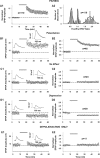

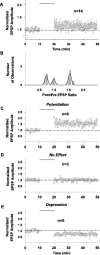
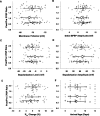

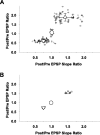
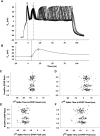
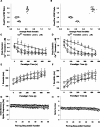
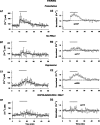

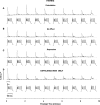
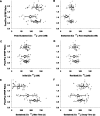
Similar articles
-
Relation between dendritic Ca2+ levels and the polarity of synaptic long-term modifications in rat visual cortex neurons.Eur J Neurosci. 1997 Nov;9(11):2309-22. doi: 10.1111/j.1460-9568.1997.tb01648.x. Eur J Neurosci. 1997. PMID: 9464925
-
Long-term depression in rat visual cortex is associated with a lower rise of postsynaptic calcium than long-term potentiation.Neurosci Res. 1996 Feb;24(3):265-74. doi: 10.1016/0168-0102(95)01001-7. Neurosci Res. 1996. PMID: 8815446
-
Role of GABAA-Mediated Inhibition and Functional Assortment of Synapses onto Individual Layer 4 Neurons in Regulating Plasticity Expression in Visual Cortex.PLoS One. 2016 Feb 3;11(2):e0147642. doi: 10.1371/journal.pone.0147642. eCollection 2016. PLoS One. 2016. PMID: 26841221 Free PMC article.
-
Postsynaptic depolarization requirements for LTP and LTD: a critique of spike timing-dependent plasticity.Nat Neurosci. 2005 Jul;8(7):839-41. doi: 10.1038/nn0705-839. Nat Neurosci. 2005. PMID: 16136666 Review.
-
The role of dendritic filtering in associative long-term synaptic plasticity.Learn Mem. 1999 Sep-Oct;6(5):422-47. doi: 10.1101/lm.6.5.422. Learn Mem. 1999. PMID: 10541464 Review.
Cited by
-
Layer 2/3 synapses in monocular and binocular regions of tree shrew visual cortex express mAChR-dependent long-term depression and long-term potentiation.J Neurophysiol. 2008 Jul;100(1):336-45. doi: 10.1152/jn.01134.2007. Epub 2008 May 14. J Neurophysiol. 2008. PMID: 18480372 Free PMC article.
-
A novel learning rule for long-term plasticity of short-term synaptic plasticity enhances temporal processing.Front Integr Neurosci. 2011 May 30;5:20. doi: 10.3389/fnint.2011.00020. eCollection 2011. Front Integr Neurosci. 2011. PMID: 21660100 Free PMC article.
-
Autonomous CaMKII mediates both LTP and LTD using a mechanism for differential substrate site selection.Cell Rep. 2014 Feb 13;6(3):431-7. doi: 10.1016/j.celrep.2014.01.005. Epub 2014 Jan 30. Cell Rep. 2014. PMID: 24485660 Free PMC article.
-
A Ca-Based Computational Model for NMDA Receptor-Dependent Synaptic Plasticity at Individual Post-Synaptic Spines in the Hippocampus.Front Synaptic Neurosci. 2010 Jul 21;2:31. doi: 10.3389/fnsyn.2010.00031. eCollection 2010. Front Synaptic Neurosci. 2010. PMID: 21423517 Free PMC article.
-
Pro-aggregant Tau impairs mossy fiber plasticity due to structural changes and Ca(++) dysregulation.Acta Neuropathol Commun. 2015 Apr 3;3:23. doi: 10.1186/s40478-015-0193-3. Acta Neuropathol Commun. 2015. PMID: 25853683 Free PMC article.
References
-
- Abraham WC, Bear MF (1996) Metaplasticity: the plasticity of synaptic plasticity. Trends Neurosci 19: 126-130. - PubMed
-
- Artola A, Singer W (1993) Long-term depression of excitatory synaptic transmission and its relationship to long-term potentiation. Trends Neurosci 16: 480-487. - PubMed
-
- Artola A, Brocher S, Singer W (1990) Different voltage-dependent thresholds for inducing long-term depression and long-term potentiation in slices of rat visual cortex. Nature 347: 69-72. - PubMed
-
- Bear MF, Cooper LN, Ebner FF (1987) A physiological basis for a theory of synapse modification. Science 237: 42-48. - PubMed
Publication types
MeSH terms
Substances
Grants and funding
LinkOut - more resources
Full Text Sources
